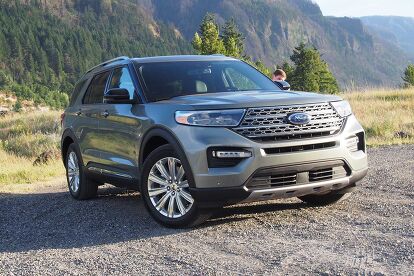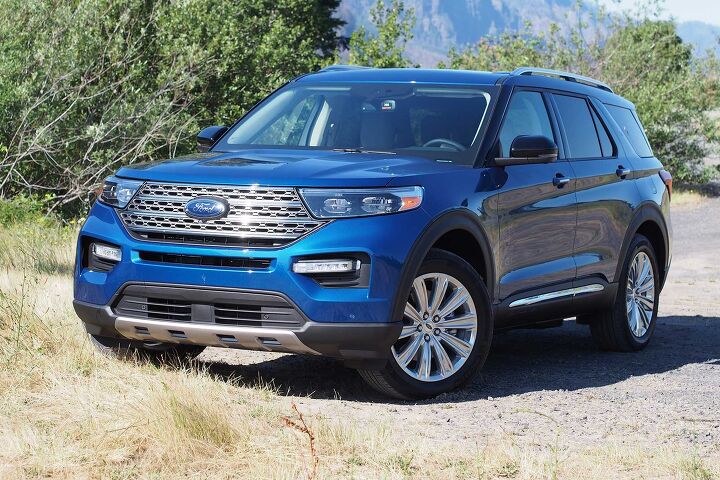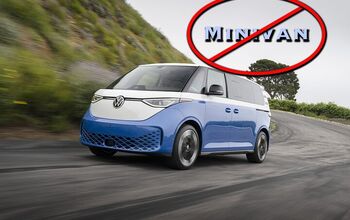2020 Ford Explorer Review - VIDEO

The 2020 Ford Explorer is totally familiar yet completely reimagined.
At first glance, you may have trouble telling it apart from the outgoing model. This perennially popular three-row SUV looks suspiciously like the version it’s replacing, from the blacked-out A-pillars to the greenhouse shape to the grille designs, countless design traits are carried over. You might be tempted to think this is just another refresh of the existing vehicle, but in this case, you’d be totally wrong.
The 2020 Explorer is all new from the platform on up, riding on Ford’s latest-and-greatest underpinnings. Sturdy and stiff, the automaker’s rear-wheel-drive-based CD6 vehicle architecture debuts with this venerable nameplate, though it will undoubtedly proliferate throughout their broader lineup.
Generation Six
Since it was first unleashed on the buying public in 1991, Explorer has sold in vast quantities. In fact, you could argue this vehicle ignited an SUV craze, the effects of which are still being felt in today’s crossover-clogged new-vehicle market. Motorists of the era were attracted to its rugged looks, hauling capability and available four-wheel-drive.
These common traits propelled the nameplate forward through five generations with about 8 million delivered by dealerships over the last three decades.
Continuing this tradition, the all-new sixth-generation model is stronger and lighter, more capable and feature-rich than ever before. Added safety, refinement and comfort further enhance this Explorer’s appeal.
By the Numbers
Not only does the 2020 model look like its predecessor, but it’s also nearly the same size. The vehicle’s length clocks in at just shy of 200 inches (5,080 millimeters) while overall width should be identical. Height is similar, too.
About the only significant alteration has been made to the wheelbase. At just a whisker more than 119 inches (3,025 millimeters) it’s been stretched by half a foot for greater versatility and, more importantly, dramatically improved exterior proportions.
SEE ALSO: 2019 Jeep Gladiator Review – VIDEO
The switch to CD6 also helped this latest Explorer lose a good bit of weight. On average, it’s dropped about 200 pounds (91 kilograms), a not-insignificant amount.
CD6 also provides far greater versatility. Inside, there’s seating for six or seven people depending on configuration. It also offers just shy of 88 cubic feet (2,486 liters) of maximum cargo space and enough width to handle four-foot-wide (1,219 millimeter) sheets of building material.
Power(trains) to the People!
Right out of the gate, Ford is offering four different powertrains in the 2020 Explorer. This means there should be an under-hood option that appeals to practically every sort of SUV shopper.
ALSO SEE: Ford Edge vs Explorer: Which SUV is Right for You?
Base, XLT and Limited models are propelled by a friendly and familiar 2.3-liter EcoBoost four-cylinder. Used to great advantage in myriad Ford and Lincoln vehicles, this engine delivers 300 horsepower and 310 pound-feet of torque in this application.
Stepping up from there, you can also get a hybrid powertrain, the first time Dearborn’s offered an electrified propulsion system in the Explorer. The brunt of the work here is done by a 3.3-liter naturally aspirated V6 that’s augmented by both port and direct fuel injection. Helping ease its burden is a small electric motor that’s bolted to the torque converter and juiced by a small, 1.5 kWh lithium-ion battery pack. Total system horsepower measures 318, torque should clock in at 330 pound-feet.
Platinum-trim Explorers are hauled around by a smooth and responsive 3.0-liter twin-turbo V6. They deliver a healthy 365 ponies with a stout 380 pound-feet of twist.
Finally, for driving enthusiasts, Ford is offering a performance-tuned ST model, another first for Explorer. It features the same six-shooter found in Platinum models, but engineers turned up the wick to 400 horses and 415 torques.
Aft of the engine, a 10-speed automatic transmission is standard across the range. It routes torque to either the rear wheels or all corners.
SEE ALSO: 2019 Nissan Titan Review
Thanks to its rear-drive architecture and proven powertrains, the 2020 Explorer offers impressive towing capability. Six-cylinder versions are rated to drag up to 5,600 pounds. When properly equipped, models with the four-cylinder engine top out at 5,300. Hybrids can handle a max of 5,000, a surprising amount for an economy-minded vehicle.
When it comes to fuel economy, rear-drive models with the four-cylinder engine are rated at 21 miles per gallon city, 28 highway and 24 mpg combined. Opt for all-wheel drive and those figures drop slightly to 20, 27 and 23, respectively (11.6 city, 8.7 highway, 10.3 combined l/100km). Grab a V6 engine with four-corner traction and you should expect 18 in the city, 24 on interstate drives and 20 in mixed use. Hybrid efficiency has not been published by the EPA just yet, but it should be revealed in short order.
Tech Offensive or Offensive Tech?
Keeping up with the Jonses, or, more specifically, the Hondas, Chevrolets and BMWs of the world, this Ford offers loads of technology.
An eight-inch touchscreen with the company’s Sync 3 infotainment system is standard, which gets you Apple CarPlay, Android Auto and even Waze integration.
Appealing to drivers that want even more electronics, a portrait-mode 10.1-inch display is offered as well. It can display multiple apps at once, though it does look pretty awkward perched atop the dashboard like a parrot on a pirate’s shoulder.
Keeping people safe, Ford Co-Pilot360 is included on all trims free of charge. This bundles features like blind-spot monitoring, lane-keeping assist, a self-cleaning back-up camera, and automatic high beams. Features like adaptive cruise control with speed-sign recognition, evasive steering assist and navigation are also available in the new Explorer. Among many additional features, wireless charging, a 12.3-inch reconfigurable digital instrument cluster, and a 14-speaker B&O audio system are on offer.
Three Cheers for Three Rows!
As for the rest of the Explorer’s interior, it’s unexpectedly excellent. Photos don’t make it look particularly appealing as there are some weird surfaces on the dashboard and the overall design seems to lack sophistication. But seeing it in person is another story entirely. Except for a bit of hard plastic, nothing is flagrantly low-rent, even in a mass-market XLT model. There are plenty of soft materials, plus the switches and controls feel like quality. Platinum-trim versions, the fanciest one offered by Ford, even feature stitched leather on the dashboard and door panels.
Is the Explorer’s cabin as premium as what you get in a BMW? No, but it’s as nice or better than the interiors of major rivals like the Honda Pilot, Toyota Highlander, Dodge Durango and Chevrolet Traverse.
As for comfort, it all depends on location. Like commercial aviation, sitting nearer the vehicle’s nose is better. The first-class front seats are superb, with plenty of support and suppleness for all-day comfort; the business-class second-row offerings are quite nice, with a chair-height lower cushion; the way back is merely satisfactory for adults as their knees will be at chin level and pressed against the second-row backrests. Basic economy is best left to kids.
ALSO SEE: 2019 Subaru Ascent vs Honda Pilot vs VW Atlas: 3-Row SUV Comparison
Complaints about this vehicle’s interior are minor. The climate controls are a little bit small and take getting used to. Also, the wireless phone charger is located in front of the center console lid. Angled back, gravity keeps your handset pressed against the pad, but even moderately hard braking can cause the device to tip forward and stop charging. Lastly, the rotary gear-selector is placed on the console, but why? If they relocated it to the dashboard they could have freed up additional space for storage, or a more reliable wireless charger.
The Drive
One of the most noticeable aspects of piloting the new Explorer is just how improved the front footwells are. In the outgoing model, there’s no space to put your feet as the pedal box is annoyingly impinged upon by various bits of vehicle structure. Fortunately, this is a thing of the past in the 2020 edition as there’s enough room down there to host a dance party. The armrests and driving position are vastly superior as well, a night-and-day difference.
XLT and Limited versions of the 2020 Explorer are likely to be the highest-volume sellers in the lineup, which also includes Ford Performance-tuned ST and the top-shelf Platinum versions, in addition to a bare-bones “Base” trim, which will become available around the November timeframe. Both of these midrange offerings are propelled by an EcoBoost four-cylinder engine, a friendly and familiar powerplant. Relatively smooth and quiet, this torquey unit moves the Explorer with surprising verve, at least once the tachometer needle hits about 3,000 rpm. At speeds less than that, it’s a touch on the soft side. Fortunately, the 10-speed transmission gives it plenty of ratios to play with so it can rev up quickly to reach the meat of its powerband.
SEE ALSO: 2019 Infiniti QX50 Review
The fuel-sipping hybrid model doesn’t feel quite as vigorous as the four-cylinder-powered Explorer, though it’s more than adequate, especially considering the improved economy it should provide. With a small, 1.5-kWh lithium-ion battery pack, this amped-up Explorer can drive silently for short distances on electrons only, a nifty feature in parking lots or stop-and-go traffic. With a stepped-ratio gearbox, the hybrid has little of the driveline weirdness often associated with vehicles that have continuously variable transmissions. It’s mostly smooth, though occasionally the powertrain will judder in certain driving situations, likely as the electric motor’s clutch engages and disengages.
For drivers that want the most performance, Ford sells an ST version of the explorer. With 400 horses in its under-hood stable, this is one fast three-row SUV. Acceleration is borderline explosive, eclipsing 60 miles an hour in a claimed 5.5 seconds, though it feels even fleeter than that, likely because of the Great Plains-broad torque band. Special chassis tuning, a freer-flowing exhaust system and optional larger brakes help it handle better. ST models also gain unique seat trim; a meatier, flat-bottomed steering wheel; and different splash-screen animations on their displays.
As for the highfalutin’ Platinum Explorer, it feels a lot like the ST, just a bit quieter and smoother. In straight-line acceleration, there doesn’t seem like much of a difference even though it’s down 35 horses.
All versions of the 2020 Explorer are hushed inside, even when driven over grainy road surfaces. They also have firm brakes and feel smaller, more tossable than the outgoing model.
The Verdict: 2020 Ford Explorer Review
The 2020 Ford Explorer is versatile, refined, drives well and offers loads of technology. In short, it’s the best Explorer ever built. But what’s not to like? Well, maybe the pricing.
That Base model mentioned earlier should start at $33,860, including $1,095 in delivery fees. That’s a net price increase of just $400 compared to last year’s version. Still, that makes it a bit more expensive than some of its major rivals. The mass-market XLT model should start around $37,770 with destination charges added in, a net increase of $2,275. Spring for a range-topping Platinum edition and plan on shelling out about $59,345, $4,085 more than last year. Naturally, Limited and ST models fall between these pricing extremes.
Ford’s latest-and-greatest Explorer should start arriving at dealerships in the next couple weeks.
The Specs
Engine: 2.3-liter turbo-four
Output: 300 horsepower, 310 pound-feet of torque
Engine: 3.0-liter twin-turbo V6
Output: 365 horsepower, 380 pound-feet of torque
Engine: high-output 3.0-liter twin-turbo V6
Output: 400 horsepower, 415 pound-feet of torque
Hybrid Drivetrain: 3.3-liter V6, one electric motor, 1.5-kWh lithium-ion battery
Output: 318 horsepower, 330 pound-feet of torque
Transmission: 10-speed automatic
Four-Cylinder RWD U.S. Fuel Economy (MPG): 21 city, 28 highway, 24 combined
Four-Cylinder AWD U.S. Fuel Economy (MPG): 20 city, 27 highway, 23 combined
V6 AWD U.S. Fuel Economy (MPG): 18 city, 24 highway, 20 combined
Four-Cylinder AWD CAN Fuel Economy (L/100 km): 11.6 city, 8.7 highway, 10.3 combined
U.S. Base-model Price: $33,860, including $1,095 in delivery fees
U.S. Platinum-model Price: $59,345, including $1,095 in delivery fees
CAN Estimated Base-model Price: $45,500
Discuss this story on our Ford Forum
LOVE IT
- Rear-wheel-drive bones
- The best Explorer ever
- Excellent powertrains
- Strong performance
- Comfortable interior
- Broad model range
LEAVE IT
- Third-row seat could be roomier
- Cluttered climate controls
- Fiddly wireless charger
- Price creep

Born and raised in metro Detroit, Craig was steeped in mechanics from childhood. He feels as much at home with a wrench or welding gun in his hand as he does behind the wheel or in front of a camera. Putting his Bachelor's Degree in Journalism to good use, he's always pumping out videos, reviews, and features for AutoGuide.com. When the workday is over, he can be found out driving his fully restored 1936 Ford V8 sedan. Craig has covered the automotive industry full time for more than 10 years and is a member of the Automotive Press Association (APA) and Midwest Automotive Media Association (MAMA).
More by Craig Cole











































































![2011 Ford Explorer Review - First Drive [Video]](https://cdn-fastly.autoguide.com/media/2023/06/26/06072/2011-ford-explorer-review-first-drive-video.jpg?size=350x220)











Comments
Join the conversation